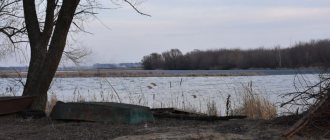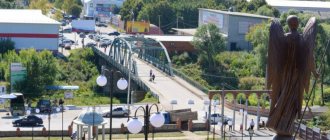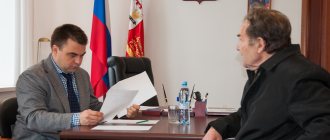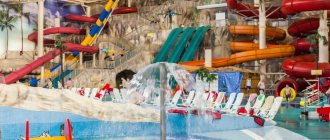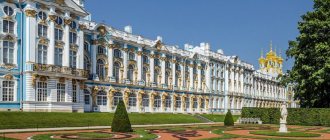Grateful
(Stavropol region)
OKATO code:
07210501
Founded:
1782
City since:
1971 City of regional subordination
Center:
Blagodarnensky district
The city was formerly called:
| Grateful | 1971 |
| Telephone code (reference phone) | |
| 86549***** | 21-4-79 |
Deviation from Moscow time, hours:
0
Geographic latitude:
45°06′
Geographic longitude:
43°26′
Altitude above sea level, meters:
160 Sunrise and sunset times in the city of Blagodarny
Content
- 1 Title
- 2 Geography
- 3 Climate
- 4 History
- 5 Population
- 6 Abolished urban settlement, the city of Blagodarny
- 7 Infrastructure
- 8 Upbringing and education
- 9 Enterprises
- 10 Transport
- 11 Media
- 12 Russian Orthodox Church
- 13 Sports
- 14 People associated with the city
- 15 Objects of archaeological and cultural heritage
- 16 Monuments
- 17 Notes
- 18 Literature
- 19 Links
Map
| Grateful: cards |
Grateful: photo from space (Google Maps) Grateful: photo from space (Microsoft Virtual Earth)
| Grateful. Nearest cities. Distances in km. on the map (in brackets along roads) + direction. Using the hyperlink in the distance , you can get the route (information courtesy of the AutoTransInfo website) | |||
| 1 | Gofitskoe | 31 (34) | Z |
| 2 | Summer Rate | 36 (119) | WITH |
| 3 | Novoselitskoye | 38 (91) | IN |
| 4 | Chernolesskoye | 46 (107) | SE |
| 5 | Svetlograd | 52 (70) | NW |
| 6 | Alexandrovskoe | 54 (87) | SW |
| 7 | Konstantinovskoe | 66 () | Z |
| 8 | Budennovsk | 66 (68) | SE |
| 9 | Arzgir | 68 (142) | NE |
| 10 | Deceased | 71 () | SE |
| 11 | Praskovey | 71 () | SE |
| 12 | Blagodatnoe | 74 () | NW |
| 13 | Ipatovo | 80 (126) | NW |
| 14 | Grachevka | 81 (108) | Z |
| 15 | Zelenokumsk | 83 (121) | SE |
| 16 | Kugulta | 87 () | Z |
| 17 | Marvelous | 90 (166) | WITH |
| 18 | Newly established | 94 () | YU |
| 19 | Staromaryevka | 94 () | Z |
| 20 | Abundant | 95 () | YU |
| 21 | Soldato-Alexandrovskoe | 95 (144) | YU |
| 22 | Alexandria | 97 (168) | YU |
| 23 | Levokumka | 98 (148) | YU |
| 24 | Andzhievsky | 99 () | YU |
| 25 | Podgornaya | 100 (167) | IN |
| 26 | Mineral water | 101 (150) | YU |
| 27 | Krasnokumskoe | 102 () | YU |
| 28 | Levokumskoe | 102 (170) | IN |
| 29 | Kursavka | 102 (222) | SW |
| 30 | Hope | 103 (167) | Z |
a brief description of
Located in the Ciscaucasia, in the northern part of the Stavropol Upland, on the river. Mokraya Buivola (tributary of the Kuma), 150 km east of Stavropol. Railway station.
Territory (sq. km): 328
Information about the city of Blagodarny on the Russian Wikipedia site
Historical sketch
Founded in 1782 as the village of Blagodarnoye; the name is artificial with a “positive” meaning.
Since 1867, the village of Blagodarnoye has been the center of the Novogrigorievsky district of the Stavropol province. In 1900, Novogrigoryevsky district was renamed Blagodarnensky.
Since September 9, 1971, the city of Blagodarny.
Economy
Food industry enterprises - JSC: Khlebopek, Lakta, Pivzavod, Agroprodukt.
Production of building materials. JSC "Metalist" (boilers, etc.).
In the Blagodarnensky region, wheat, barley, oats, peas, buckwheat, corn, sunflowers, potatoes, vegetables, grapes, fruit and melon crops are grown. They raise cattle, sheep, pigs, and goats. Poultry farming.
Deposits of natural gas (Mirnoe village), limestone, sand, clay.
Main enterprises
BUILDING MATERIALS INDUSTRY
OJSC Blagodarny KPP
356400, Stavropol Territory, Blagodarny, st.
Zavokzalnaya, 1 Offers:
Silicate brick
OJSC Blagodarnensky Concrete Concrete Plant
356400, Stavropol region, Blagodarny, st.
Zavokzalnaya, 3 Offers:
Efficiency parts, prefabricated reinforced concrete products and structures
Museums, galleries, exhibition halls
Blagodarny Museum of Local Lore 356400, Stavropol Territory, Blagodarny, st. Sovetskaya, 235-a Phone(s): (86549) 23-787
Architecture, sights
Architectural monuments of the late 19th century. - early 20th century
| Population by year (thousands of inhabitants) | |||||||
| 1897 | 12.2 | 1996 | 33.3 | 2007 | 33.3 | 2015 | 31.7 |
| 1939 | 16.1 | 1998 | 34.0 | 2008 | 33.1 | 2016 | 31.6 |
| 1959 | 14.9 | 2000 | 34.3 | 2010 | 33.1 | 2017 | 31.3 |
| 1970 | 20.2 | 2001 | 34.0 | 2011 | 32.7 | 2018 | 31.1 |
| 1979 | 22.7 | 2003 | 34.5 | 2012 | 32.4 | 2019 | 30.5 |
| 1989 | 27.8 | 2005 | 33.8 | 2013 | 32.1 | 2020 | 30.4 |
| 1992 | 29.9 | 2006 | 33.6 | 2014 | 32.0 | 2021 | 30.3 |
Title[ | ]
One of the first researchers of the history of Blagodarnoye, priest Vasily Andreevich Belogradsky, in his essay “The Village of Blagodarnoye”, published in the “Collection of statistical information about the Stavropol province” for 1868, provides information about its two names [4]:
Grateful
, appropriated by one of the regional leaders of the Caucasus, and
Soldatskoe
, hitherto stubbornly held by nomadic neighbors - Kalmyks and Trukhmyans.
The second of these names, according to Belogradsky, was also pronounced “Saldutskoe”
or
“Soldus”
[5].
In the book by Anton Ivanovich Tvalchrelidze “Stavropol province in statistical, geographical, historical and agricultural relations” (1897) there is another option - “Soldutskoe”
.
At the same time, the author of the publication about - Kalmyks, Turkmens and Nogais - this name “was given to all Russian settlements without distinction”
[6].
The origin of another name is “Grateful”
- is associated with a historical legend, which, for example, is described in the above-mentioned essay by Belogradsky:
The government ordered the placement of retired family soldiers, about 20 families, in this very place. (...) The settled soldiers really liked living in this place, because there was a lot of water (a river flowed nearby with fish), forests were abundant, the pastures were luxurious, and agriculture was satisfactory. Therefore, when the regional chief arrived to visit the new residents of Buffalo, they met him with bread and salt and, as a token of their gratitude for delivering a good life, presented him with some gift; but the boss told them: “I don’t need your gifts, gentlemen, servants, live to your health. And because you are grateful, let your village be called Grateful.”
This legend was later reflected in the symbolism of the Blagodarnensky municipal district.
Population[ | ]
| Population | ||||||||||
| 1789[22] | 1806[23] | 1812[24] | 1819[24] | 1897[25] | 1902[9] | 1903[26] | 1908[27] | 1939[28] | 1959[29] | 1970[30] |
| 225 | ↘211 | ↗779 | ↗1064 | ↗12 212 | ↗12 877 | ↗13 049 | ↘12 715 | ↗16 089 | ↘14 900 | ↗20 168 |
| 1979[31] | 1989[32] | 1992[33] | 1996[33] | 1998[33] | 2000[33] | 2001[33] | 2002[34] | 2003[33] | 2005[33] | 2006[33] |
| ↗22 706 | ↗27 828 | ↗29 900 | ↗33 300 | ↗34 000 | ↗34 300 | ↘34 000 | ↗34 500 | →34 500 | ↘33 800 | ↘33 600 |
| 2007[33] | 2008[35] | 2009[36] | 2010[37] | 2011[38] | 2012[39] | 2013[40] | 2014[41] | 2015[42] | 2016[43] | 2017[44] |
| ↘33 300 | ↘33 100 | ↘33 026 | ↘32 725 | ↗32 728 | ↘32 435 | ↘32 148 | ↘31 959 | ↘31 720 | ↘31 558 | ↘31 293 |
| 2018[45] | 2019[46] | 2020[47] | 2021[1] | |||||||
| ↘31 100 | ↘30 530 | ↘30 399 | ↘30 333 | |||||||
As of January 1, 2022, in terms of population, the city was in 497th place out of 1,116[48]cities of the Russian Federation[49].
National composition
According to the results of the 2010 population census, the following nationalities lived (nationalities less than 1%, see footnote to the line “Others”)[50]:
| Nationality | Number | Percent |
| Russians | 26 817 | 81,95 |
| Gypsies | 2437 | 7,45 |
| Armenians | 1181 | 3,61 |
| Turks | 582 | 1,78 |
| Others[51] | 1708 | 5,22 |
| Total | 32 725 | 100,00 |
Upbringing and education[ | ]
- Kindergarten No. 2[66]
- Kindergarten No. 3[67]
- Kindergarten No. 5[68]
- Kindergarten No. 7[69]
- Kindergarten No. 9[70]
- Kindergarten No. 28[71]
- Kindergarten No. 29[72]
- Kindergarten No. 30[73]
- Special (correctional) primary school - kindergarten No. 1[74]
- Secondary school No. 1 named after Maxim Gorky[75]. Opened on September 30, 1911 as a pro-gymnasium[76]
- Secondary school No. 6[77]
- Secondary school No. 9[78]
- Secondary school No. 15[79]
- Evening (shift) general education school[80]
- Agrotechnical College[81]
- Children's art school[82]
- Children's and youth sports school[83]
- House of Children's Creativity[84]. Opened January 23, 1940[85]
- Center for Additional Education for Children[86]
- Children's health and educational (profile) [87]
- Orphanage (mixed) No. 16 named after M. N. Pokrovsky[88]
- Social rehabilitation center for minors "Harmony"[89]
Literature[ | ]
- Administrative-territorial structure of Stavropol from the end of the 18th century to 1920: [arch. October 23, 2018] / G. A. Nikitenko (responsible compiler), E. B. Gromova, M. I. Krivneva; Committee of the Stavropol Territory for Archives, State Archives of the Stavropol Territory. - Stavropol, 2008. - 705 p.
- Belogradsky V.
The village of Blagodarnoye: [arch. March 21, 2016]: essay // Collection of statistical information about the Stavropol province. - 1868. - Issue. 1. - pp. 130-138. - Tvalchrelidze, A.
Stavropol province in statistical, geographical, historical and agricultural relations / A. Tvalchrelidze; Sov. cultural fund, Stavrop. edges department — Rep. ed. 1897 - Stavropol: Caucasian Library, 1991. - P. 251-260. — 750 s. — ISBN 5-88530-046-1.
Infrastructure[ | ]
- Leisure. Abolished at the beginning of 2014[59]
- Intersettlement centralized library system[60]
- Museum of History and Local Lore named after Pyotr Fedorovich Gribtsov[61]
- Kolos Stadium[62]
- Central district hospital[63]
- Boarding house for the elderly and disabled[64]
- District House of Culture
- Cemeteries: closed - Chapaevskoye
(in the central part of the city), with an area of 30,000 m²,
Yuzhnoye
(southwestern part), with an area of 29,000 m²;
open - Melnichnoe
(southern outskirts), with an area of 100,000 m², and
Severnoe
(northern part), with an area of 80,000 m²[65]
People associated with the city[ | ]
| The list of examples in this section is not based on authoritative sources devoted directly to the subject of the article or its section. Add links to sources whose subject matter is the topic of this article (or section) as a whole, and not individual elements of the list. Otherwise, the section may be deleted. This mark was set on February 26, 2022 . |
- Anastasia Pavlovna Bednenko (1924-1971) - tractor driver of the Krasnaya Zvezda collective farm in the Blagodarnensky district of the Stavropol Territory. Hero of Socialist Labor (04/08/1971). Knight of two Orders of Lenin (01/11/1957; 04/08/1971), Order of the Red Banner of Labor (06/26/1952). Honorary resident of the city of Blagodarny (2014)[94][95].
- Bocharova Evdokia Davydovna (1913-1982) - Soviet pilot, commander of the 46th Guards Night Bomber Aviation Regiment. Participant of the Great Patriotic War. The only woman awarded the Order of Suvorov. Graduate of Blagodarny secondary school No. 1.
- Boris Kuzmich Elisov (1926, Blagodnoye village - 1989) - Soviet law enforcement official, colonel general of the internal service. Participant of the Great Patriotic War.
- Nina Nikolaevna Morozhenko[uk] (nee Semyonova; 1928-2009) - Soviet astronomer, Doctor of Physical and Mathematical Sciences, scientific secretary of the Main Astronomical Observatory of the Ukrainian Academy of Sciences.
- Petrovsky Boris Vasilievich (1908-2004) - Soviet and Russian surgeon, scientist and clinician; health care organizer and social activist. Doctor of Medical Sciences, Professor. Minister of Health of the USSR (1965-1980). Until 1916, he lived with his family in the village of Blagodarny, Blagodarny district, Stavropol province.
- Ryazantsev Sergey Vasilievich (born 1973) is a Russian economist, corresponding member of the Russian Academy of Sciences. Doctor of Economic Sciences, Professor. Head of the Center for Social Demography and Economic Sociology at the Institute of Socio-Political Research of the Russian Academy of Sciences. Until the age of 17 [ source not specified 2031 days
] he lived in Blagodarny. - Sidelnikov Andrey Nikanorovich (1895, village of Blagodarnoye - 1983) - Soviet military leader, lieutenant general, Honorary Citizen of the city of Blagodarnoye.
- Dineikin Grigory Ivanovich [uk] - director of the Severodonetsk thermal power plant (CHP) of the Voroshilovgrad region, deputy minister of energy and electrification of Ukraine. People's Deputy of Ukraine of the 2nd convocation.
- Svetlana Valentinovna Klimenko (born 1937) is a Soviet and Ukrainian biologist.
- Tikhenko Igor Fedorovich (born 1961) - poet, bard, artist. Member of the Creative Union of Artists of Russia. Author of the first coat of arms of the city of Blagodarny (1999)[96][97][98][99].
The abolished urban settlement of the city of Blagodarny[ | ]
Abolished on May 1, 2022[20][21][21].
Symbolism
Until 2022, the official symbols of the urban settlement were the coat of arms and flag[52][53], developed with the participation of the Union of Heraldists of Russia by a team of authors consisting of: I. F. Tikhenko (coat of arms idea), K. F. Mochenov (heraldic revision), R E. Nazarov (artist), G. A. Rusanova (design), K. V. Perekhodenko (substantiation of the symbolism of the coat of arms)[54][55].
In 2022, the heraldic commission under the governor of the Stavropol Territory recommended that settlements that had lost the status of municipalities transform their coats of arms into emblems[56].
Head of city administration
- 2011-2015 - Svetlana Anatolyevna Lobkareva[57].
- 2015-2017 - Dmitry Aleksandrovich Tormosov, head of the city[58].

